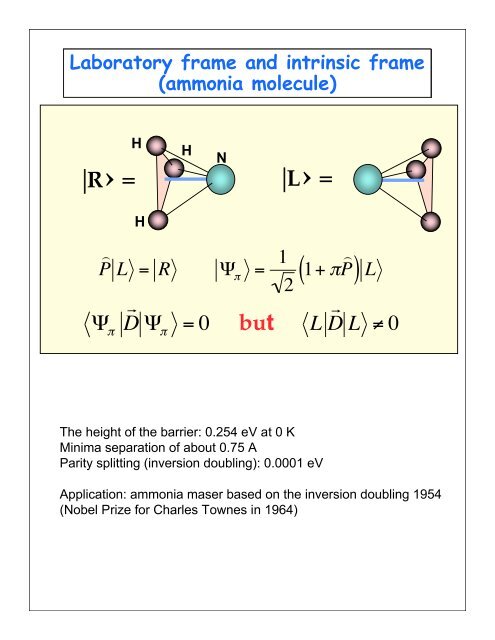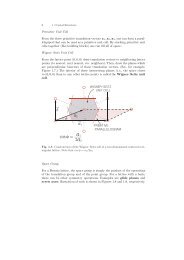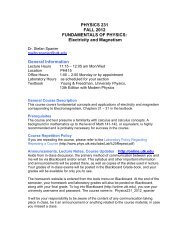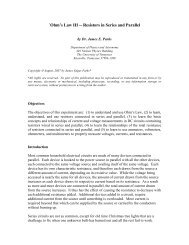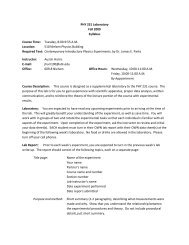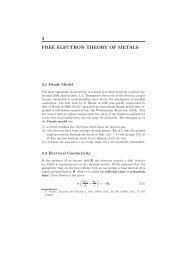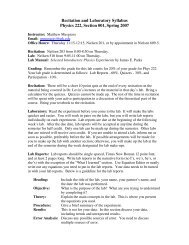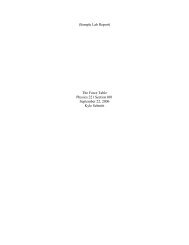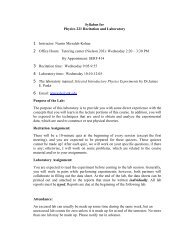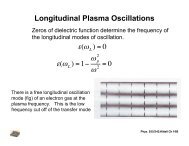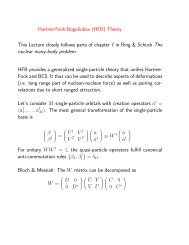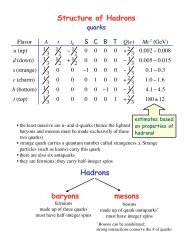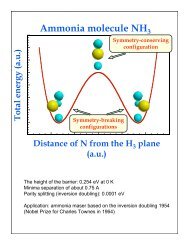Spontaneous symmetry breaking
Spontaneous symmetry breaking
Spontaneous symmetry breaking
You also want an ePaper? Increase the reach of your titles
YUMPU automatically turns print PDFs into web optimized ePapers that Google loves.
Laboratory frame and intrinsic frame<br />
(ammonia molecule)<br />
H<br />
H<br />
H<br />
|R› = |L› =<br />
" #<br />
r<br />
D " #<br />
= 0<br />
N<br />
)<br />
P L = R " #<br />
= 1 2 1+ # P<br />
)<br />
but<br />
( ) L<br />
L r<br />
D L " 0<br />
!<br />
!<br />
The height of the barrier: 0.254 eV at 0 K<br />
Minima separation of about 0.75 A<br />
Parity splitting (inversion doubling): 0.0001 eV<br />
Application: ammonia maser based on the inversion doubling 1954<br />
(Nobel Prize for Charles Townes in 1964)
The transition matrix element between the members of the doublet<br />
carries important information about the collectivity of the system.<br />
The normalized signature-projected LM wave functions are:<br />
Since K x is signature-odd, one has<br />
Consequently, the transition matrix element is:<br />
For large values of χ, this matrix element becomes<br />
In the limit of large χ, the transition matrix element carries<br />
information about the deformation of the system!
Laboratory frame and intrinsic frame<br />
(molecular or nuclear quadrupole moment)<br />
Q =<br />
2K 2 -I(I+1)<br />
Q<br />
(I+1)(2I+3) 0<br />
MEASURED<br />
INTRINSIC<br />
RELATIVE<br />
MOTION<br />
Q=0 for I=K=0, independently of Q 0 !
Symmetry <strong>breaking</strong><br />
q = !<br />
= 0 but<br />
0 0 0<br />
Q ˆ<br />
! crit<br />
E<br />
ω RPA<br />
=0<br />
ω RPA<br />
>0 ω RPA<br />
-<br />
imag.<br />
Vibrator<br />
(weak<br />
coupling)<br />
Soft<br />
(interm.<br />
coupling)<br />
Rotor<br />
(strong<br />
coupling)<br />
No phase<br />
Band structures<br />
transition<br />
labelled by<br />
in the finite<br />
different q.n.<br />
system!<br />
[ H ˆ S ˆ ] h ˆ , S ˆ<br />
deformed<br />
intrinsic<br />
system!<br />
Q 2 !<br />
“exact”<br />
mean field<br />
of the internally<br />
broken symmetries<br />
[ ] ! 0
Nuclear deformation:<br />
spontaneous <strong>symmetry</strong> <strong>breaking</strong><br />
Molecular physics: Jahn-Teller effect 1937<br />
Any configuration of atoms or ions (except a<br />
linear chain) can develop a stable <strong>symmetry</strong><strong>breaking</strong><br />
deformation provided the coupling<br />
between degenerate electronic excitations and<br />
collective molecular vibrations is strong.<br />
Nuclear physics: Bohr-Mottelson 1952-53<br />
Any nuclear configuration can develop a stable<br />
<strong>symmetry</strong>-<strong>breaking</strong> deformation provided the<br />
coupling between degenerate single-nucleonic<br />
excitations and collective nuclear modes is<br />
strong.<br />
The unified model. Particle vibration coupling<br />
V int<br />
= !" r<br />
( ) # $µ<br />
$µ<br />
( )<br />
% Y $µ<br />
&
Intrinsic symmetries<br />
5 - ν=1<br />
3 -<br />
1 -<br />
(parallel band)<br />
D •h (C 2 , P)<br />
O<br />
C<br />
O<br />
6 +<br />
4 +<br />
2 +<br />
0 +<br />
ν=0<br />
(ground band)<br />
CO 2<br />
- an axially symmetric molecule with no static dipole moment.<br />
O<br />
C<br />
O<br />
C •ν (S=C 2 P)<br />
3 -<br />
2 +<br />
O N<br />
4 +<br />
1 -<br />
0 +<br />
N 2<br />
O - an axially symmetric molecule with static dipole moment.


